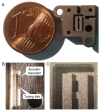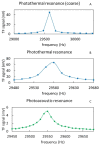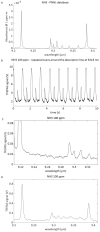Additively Manufactured Detection Module with Integrated Tuning Fork for Enhanced Photo-Acoustic Spectroscopy
- PMID: 36236300
- PMCID: PMC9573196
- DOI: 10.3390/s22197193
Additively Manufactured Detection Module with Integrated Tuning Fork for Enhanced Photo-Acoustic Spectroscopy
Abstract
Starting from Quartz-Enhanced Photo-Acoustic Spectroscopy (QEPAS), we have explored the potential of a tightly linked method of gas/vapor sensing, from now on referred to as Tuning-Fork-Enhanced Photo-Acoustic Spectroscopy (TFEPAS). TFEPAS utilizes a non-piezoelectric metal or dielectric tuning fork to transduce the photoacoustic excitation and an optical interferometric readout to measure the amplitude of the tuning fork vibration. In particular, we have devised a solution based on Additive Manufacturing (AM) for the Absorption Detection Module (ADM). The novelty of our solution is that the ADM is entirely built monolithically by Micro-Metal Laser Sintering (MMLS) or other AM techniques to achieve easier and more cost-effective customization, extreme miniaturization of internal volumes, automatic alignment of the tuning fork with the acoustic micro-resonators, and operation at high temperature. This paper reports on preliminary experimental results achieved with ammonia at parts-per-million concentration in nitrogen to demonstrate the feasibility of the proposed solution. Prospectively, the proposed TFEPAS solution appears particularly suited for hyphenation to micro-Gas Chromatography and for the analysis of complex solid and liquid traces samples, including compounds with low volatility such as illicit drugs, explosives, and persistent chemical warfare agents.
Keywords: PAS; gas analyzer; interferometric readout; micro additive manufacturing; tuning fork.
Conflict of interest statement
The authors declare no conflict of interest.
Figures








References
-
- Kosterev A.A., Tittel F.K., Serebryakov D.V., Malinovsky A.L., Morozov I.V. Applications of quartz tuning forks in spectroscopic gas sensing. Rev. Sci. Instrum. 2005;76:043105. doi: 10.1063/1.1884196. - DOI
-
- Ma Y. Review of Recent Advances in QEPAS-Based Trace Gas Sensing. Appl. Sci. 2018;8:1822. doi: 10.3390/app8101822. - DOI
MeSH terms
Substances
Grants and funding
LinkOut - more resources
Full Text Sources
Medical

